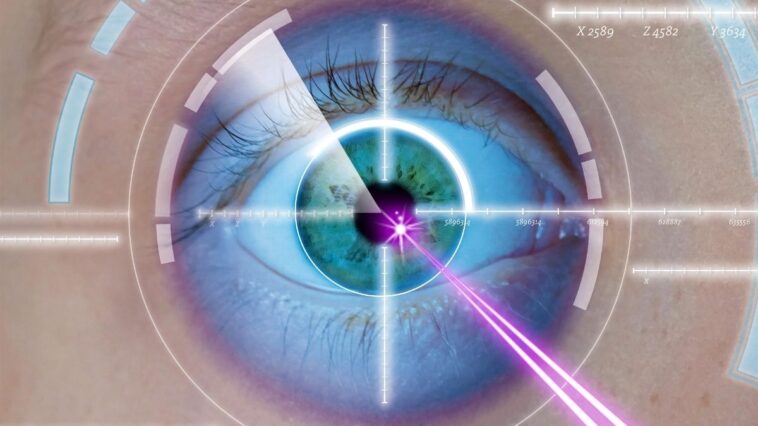What is LASEK Eye Surgery?
LASEK (Laser-Assisted Sub-Epithelial Keratectomy) is an eye surgery that uses laser technology to correct vision issues, such as nearsightedness, farsightedness, and astigmatism. This procedure reshapes the cornea to improve one’s visual acuity.
The laser energy used is gentler than other vision correction surgeries, such as LASIK, making it a more suitable option for certain patient situations.
It is similar to another laser eye surgery called PRK (Photorefractive Keratectomy), but the way the outer layer of the cornea is treated is different.
In LASEK surgery, the epithelium is loosened with alcohol and then pushed to the side before the laser is used to reshape the underlying corneal tissue. After the laser treatment, the epithelium is replaced and allowed to heal over the treated area.
LASEK surgery may be a good option for people with thin corneas or who participate in contact sports, as it may be less likely to cause problems with the integrity of the cornea than PRK surgery.
LASEK surgery is usually performed on an outpatient basis and takes only a few minutes to complete. It is generally safe and effective, and most people can return to normal activities within a few days of the procedure.
However, as with any surgery, risks and potential complications are involved. It is essential to carefully weigh the benefits and risks before deciding whether LASEK surgery is right for you.
Reasons for Undergoing LASEK
LASEK eye surgery is a corrective procedure used to treat certain vision issues, such as nearsightedness, farsightedness, and astigmatism. These conditions are caused by either an irregular cornea shape or by the eye’s incorrect length. This refractive surgery helps to reshape the cornea so that light entering the eye is properly focused onto the retina for clear vision.
LASEK surgery can reshape the cornea and improve how light is focused on the retina. This can reduce or eliminate the need for eyeglasses or contact lenses.
LASEK surgery is also recommended for people with thin corneas or who participate in contact sports, as it is less likely to cause problems with the integrity of the cornea than PRK surgery.
Other reasons for undergoing LASEK surgery may include the following:
- To improve visual acuity and reduce the need for glasses or contacts
- To correct vision problems that cannot be corrected with glasses or contacts
- To reduce the risk of eye injuries in people who participate in contact sports
- To improve appearance by eliminating the need for glasses or contacts
It’s important to note that LASEK surgery is not suitable for everyone and that the decision to have the surgery should be made after careful consideration and consultation with an eye doctor.
Benefits of LASEK Treatments
There are several benefits to LASEK treatments:
- LASEK surgery is less invasive than other types of laser eye surgery. It does not involve the creation of a flap in the cornea like LASIK surgery does, so there is less risk of complications.
- LASEK surgery may be a good option for people with thin corneas or who participate in contact sports, as it may be less likely to cause problems with the integrity of the cornea than PRK surgery.
- LASEK surgery has a shorter recovery time than PRK surgery. Most people can see well enough to drive within a few days of the procedure.
- LASEK surgery has a high success rate. Most people achieve 20/20 vision or better after the procedure.
- LASEK surgery is relatively painless. Most people do not experience significant discomfort after the procedure.
- LASEK surgery is a permanent solution to vision problems. Once the surgery is successful, people will not need to wear eyeglasses or contact lenses to correct their vision.
Who’s Eligible for LASEK Surgery?
LASEK surgery may be an option for people with vision problems such as nearsightedness, farsightedness, and astigmatism, which are unsuitable candidates for LASIK surgery. LASEK surgery may be particularly suitable for people with thin corneas or who participate in contact sports, as it may be less likely to cause problems with the integrity of the cornea than PRK surgery.
However, LASEK surgery is not suitable for everyone. It is not recommended for people with certain medical conditions, such as autoimmune diseases or uncontrolled diabetes. It’s not recommended for pregnant or nursing people, as the hormones associated with pregnancy can affect the shape of the cornea.
You must consult an ophthalmologist to determine if you are a suitable candidate for LASEK surgery. They will be able to assess your specific situation and advise you on the best course of action.
Risks and Potential Complications
LASEK eye surgery carries risks and potential complications like any surgical procedure. These can include:
- Infection: As with any surgery, there is a risk of infection following LASEK surgery. This risk can be minimized by following the surgeon’s instructions for post-operative care.
- Dry eye: Some people may experience dry eye after LASEK surgery. This can usually be managed with artificial tears or other medications.
- Light sensitivity: Some people may experience light sensitivity following LASEK surgery. This usually goes away on its own within a few days or weeks.
- Undercorrection or overcorrection: In some cases, LASEK surgery may not entirely correct vision problems or overcorrect them. This can usually be corrected with glasses or surgery.
- Regression: In some cases, the effects of LASEK surgery may decrease over time, and eyeglasses or contact lenses may be needed again.
It is essential to discuss the risks and potential complications of LASEK surgery with a qualified eye doctor before deciding whether to undergo the procedure.
The Steps Involved During LASEK Eye Surgery
LASEK eye surgery involves the following steps:
- Preparation: Before the surgery, the surgeon will numb your eyes with anesthetic drops. You will also be given a mild sedative to help you relax.
- Creating the epithelial flap: The surgeon will use a blade or laser to loosen the epithelial cells on the cornea’s surface. The epithelial flap is then lifted to the side.
- Reshaping the cornea: The surgeon will use a laser to reshape the cornea based on the specific vision problem being corrected.
- Replacing the epithelial flap: The surgeon will then replace the epithelial flap and smooth it down.
- Closing the surgery: The surgeon will apply a protective contact lens to your eye and cover it with a patch.
The entire procedure takes about 30 minutes to an hour per eye.
Before, During, and After Care Tips
Some tips for before, during, and after LASEK surgery are the following:
Before surgery:
- Stop wearing contact lenses: You should stop wearing contact lenses at least a week before LASEK surgery, as they can alter the shape of your cornea.
- Don’t wear makeup: Don’t wear makeup on the day of surgery.
- Avoid certain medications: Take an aspirin and non-steroidal anti-inflammatory drugs (NSAIDs) for at least a week before surgery, as they can increase the risk of bleeding.
- Arrange for transportation: Make sure you have someone to drive you home after the surgery.
During surgery:
- Relax: Try to stay as relaxed as possible during the surgery.
- Follow the surgeon’s instructions: It is essential to follow the surgeon’s instructions during the procedure.
After surgery:
- Follow the surgeon’s instructions: It is essential to follow the surgeon’s instructions for post-operative care, including taking any prescribed medications and using eye drops.
- Protect your eyes: Wear sunglasses to protect your eyes from bright light, and avoid rubbing your eyes.
- Avoid strenuous activities: Avoid strenuous activities for a few days after the surgery.
- Avoid getting water in your eyes: Avoid getting water while showering or swimming for at least a week after the surgery.
- Attend follow-up appointments: Attend all follow-up appointments with your surgeon to monitor your progress.
Advantages and Disadvantages of LASEK Eye Surgery
Here are some advantages and disadvantages of LASEK eye surgery:
Advantages:
- LASEK eye surgery is a less invasive form of laser vision correction than LASIK. Instead of making a flap in the cornea like in LASIK, LASEK involves loosening and lifting corneal tissue. This procedure has a lower risk of complications than LASIK, making it an ideal option for people who are not good candidates for the latter.
- LASEK surgery may be a good option for people with thin corneas or who participate in contact sports, as it may be less likely to cause problems with the integrity of the cornea than PRK surgery.
- LASEK surgery has a shorter recovery time than PRK surgery. Most people can see well enough to drive within a few days of the procedure.
- LASEK surgery has a high success rate. Most people achieve 20/20 vision or better after the procedure.
- LASEK surgery is relatively painless. Most people do not experience significant discomfort after the procedure.
- LASEK surgery is a permanent solution to vision problems. Once the surgery is successful, people will not need to wear contact lenses or eyeglasses to correct their vision.
Disadvantages:
- LASEK surgery can be more expensive than other types of vision correction surgery.
- There is a risk of complications, such as infection, dry eye, and light sensitivity.
- In some cases, LASEK surgery may not entirely correct vision problems, or it may overcorrect them. This can usually be corrected with glasses or surgery.
- The effects of LASEK surgery may decrease over time, and glasses or contact lenses may be needed again.
It is essential to weigh the advantages and disadvantages of LASEK surgery and to discuss them with a qualified eye doctor before making a decision.
How Long Is the Recovery Time for LASEK?
The recovery time for LASEK surgery is typically shorter than for PRK surgery. Most people can see well enough to drive within a few days of the procedure. However, it may take several weeks for the vision to stabilize fully. During this time, it is important to avoid rubbing the eyes and follow the surgeon’s instructions for post-operative care, including using any prescribed medications and eye drops.
It is also important to attend follow-up appointments with the surgeon to monitor the healing process and ensure the desired visual acuity is achieved.
The recovery time for LASEK surgery is generally shorter than for other laser eye surgery types, such as LASIK. However, the recovery time depends on the individual and the specific circumstances of the surgery.
Post-operative Recovery, Care, and Results
After LASEK eye surgery, it is normal to experience discomforts, such as tearing, light sensitivity, and a feeling of having something in the eye. The surgeon will prescribe pain medication and eyedrops to help manage these symptoms.
Most people can see well enough to drive within a few days of the surgery, but vision may take several weeks to stabilize fully. During this time, it is important to avoid rubbing the eyes and follow the surgeon’s instructions for post-operative care, including using any prescribed medications and eye drops.
It is also important to attend follow-up appointments with the surgeon to monitor the healing process and ensure the desired visual acuity is achieved.
In general, LASEK surgery has a high success rate, with most people achieving 20/20 vision or better after the procedure. However, the effects of the surgery can decrease over time, which may require eyeglasses or contact lenses.






